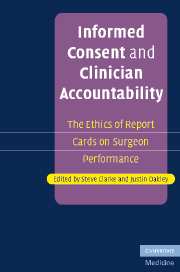Book contents
- Frontmatter
- Contents
- List of contributors
- Acknowledgements
- Introduction: Accountability, informed consent and clinician performance information
- Part I Accountability
- Part II Informed consent
- Part III Reporting performance information
- Part introduction
- 13 Is the reporting of an individual surgeon's clinical performance doing more harm than good for patient care?
- 14 Examining the link between publicly reporting healthcare quality and quality improvement
- 15 Hospital and clinician performance data: what it can and cannot tell us
- 16 An ethical analysis of the defensive surgery objection to individual surgeon report cards
- 17 Surgeon report cards and the concept of defensive medicine
- 18 Training, innovation and surgeons' report cards
- 19 Doctors' report cards: a legal perspective
- Index
- References
18 - Training, innovation and surgeons' report cards
Published online by Cambridge University Press: 08 August 2009
- Frontmatter
- Contents
- List of contributors
- Acknowledgements
- Introduction: Accountability, informed consent and clinician performance information
- Part I Accountability
- Part II Informed consent
- Part III Reporting performance information
- Part introduction
- 13 Is the reporting of an individual surgeon's clinical performance doing more harm than good for patient care?
- 14 Examining the link between publicly reporting healthcare quality and quality improvement
- 15 Hospital and clinician performance data: what it can and cannot tell us
- 16 An ethical analysis of the defensive surgery objection to individual surgeon report cards
- 17 Surgeon report cards and the concept of defensive medicine
- 18 Training, innovation and surgeons' report cards
- 19 Doctors' report cards: a legal perspective
- Index
- References
Summary
The community stands in awe of cardiac surgeons, who daily stop and restart the beating heart, symbolic of life itself. The community also has a high regard for neurosurgeons who, somewhat less dramatically, not only save lives, but may in addition be able to prevent a life of paralysis or dementia. Other surgeons occupy lesser positions on the pedestal, depending on their work. So avid is the public for surgical stories, it could be argued, that the term ‘the wonders of modern surgery’ has become hackneyed; wearied by a string of TV shows from Ben Casey to ER, House and Grey's Anatomy, not to mention countless numbers of newspaper articles, magazine features and books on the subject.
But all surgeons stand on the shoulders of their predecessors. The current state is the product of a process, gradual at first, which has followed an exponential path over about a 150 years since the discovery of anaesthesia let the ethereal genie out of the bottle. Many more than three wishes have been granted, and perhaps surgical success has become so trite that some fundamental truths are overlooked.
The progress from which we now benefit can only have been achieved by a process of trial and error involving human subjects. It seems singularly unlikely that the necessary experimentation was always conducted in a way that would satisfy modern ethical standards, yet we incorporate the knowledge in our current practice anyway.
The individual cardiac, neuro- and other surgeons that we so admire have not arrived at the height of their powers by some form of transmutation, but rather by means of a very human process of learning, involving, as it always does, trial and error. For surgeons, the trial and error involves – and adversely affects – human subjects.
- Type
- Chapter
- Information
- Informed Consent and Clinician AccountabilityThe Ethics of Report Cards on Surgeon Performance, pp. 266 - 278Publisher: Cambridge University PressPrint publication year: 2007



